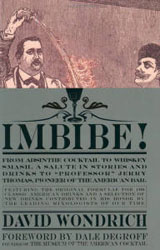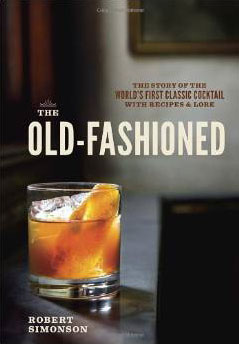Circa 1800, the Cocktail was a “hair of the dog” morning drink that tamed spirits with water, sugar and bitters (patent medicine). The late 19th Century expanded the use of the word “cocktail” to encompass just about any mixed drink. Since then, the Old Fashioned—literally, the old-fashioned way of making a cocktail—has been our contemporary expression of the original drink.
During the 20th Century, various bad ideas encrusted the Old Fashioned. Here we will strip off those barnacles to expose the amazingly simple and sublime drink beneath.
Step 1
Take a glass.
An “old fashioned glass” or “double old fashioned glass” is ideal. These glasses, also known as rocks glasses and double rocks glasses, are tumblers with straight sides and a thick bottom. Clear, uncolored and relatively undecorated glass is ideal because the Old Fashioned is a comely drink on its own. In a pinch, any glass will do.
Tip: the size of glass you want will depend on whether you plan to add ice or not.
Step 2
Add sugar to taste.
Sugar (and the scant water it is dissolved in) mellows the spirit of the drink. Not much is required, just a little, as the quality of today’s spirits is so much higher than it typically was when the Old Fashioned was born. A little splash of simple syrup generally suffices. Gum syrup, rich simple syrup, demerara syrup, brown sugar syrup, sugar cane syrup (the variety filtered of molasses solids) all are great choices. Agave syrup or other neutral diet-sensitive sweeteners may suffice.
Honey, maple syrup, molasses or other strongly-flavored sweeteners do not belong in an Old Fashioned, which is not to say you cannot or should not create nice variations on the Old Fashioned with them.
There exists a venerable tradition of sweetening the Old Fashioned with crystalized sugar or a sugar cube. You can indeed use crystalized sugar, but it’s more work: you’ll have to wet it with a few drops of water and work it until it dissolves into a syrup before proceeding. Crystalized sugar won’t dissolve on its own once you add the spirits. If you add spirits before dissolving the sugar, you’ll wind up with an unsweetened drink and a gritty sludge of sugar in the bottom of the glass.
Step 3
Add one or more dashes of aromatic bitters, to taste.
Aromatic bitters don’t make a drink taste bitter. Rather, they bind the flavors of the drink and contribute botanicals (the medicine) that make the Old Fashioned a genuine aperitif cocktail. (An aperitif stimulates the appetite.)
When getting started with the Old Fashioned, you should always use Angostura bitters. Angostura bitters is the ubiquitous benchmark aromatic bitters and always the default choice when no brand is specified. Angostura bitters always works.
As of this writing, there are at least two dozen novel aromatic bitters on the market: you are encouraged to experiment freely with them only after you’ve mastered the drink with Angostura bitters. Some of these new bitters will work well and others will disappoint, and success may depend on the spirits you pair with them. You can also combine bitters. For example, when putting bourbon in my Old Fashioned, I sometimes like to use one dash of Angostura bitters and one dash of orange bitters.
A “dash” is a somewhat arbitrary quantity. A dash has the volume of several drops. A dash is what you get from a single shake of a bottle that has an integrated “dasher top”, such as Angostura bitters. Unfortunately, the volume these bottles emit in a single squirt varies significantly depending on the design of the dasher top, the volume of liquid in the bottle, and how vigorously you shake it. Don’t worry too much about it. Your experience will guide you.
Just make sure a little bitters gets in the drink, or it’s not an Old Fashioned.
Step 4
Add a measure (2 oz, give or take) of your choice of spirit.
Initially, your choice of spirit should be from any of the scores of fine bourbons and straight rye whiskeys on the market.
Why bourbon & rye? When made with today’s bourbons and straight ryes, the Old Fashioned is bullet-proof. These are simply the easiest spirits to master the Old Fashioned with. In fact, the Old Fashioned is a brilliant way to experiment with and compare these whiskies.
There’s much more to talk about here, such as Canadian whisky, brandy, genever, and variations with tequila and rum, but let us not get distracted just yet. Go find some bourbon or straight rye.
Pause!
Look at what you’ve got in your glass.
Give it a stir. Smell it. Taste it.
That’s an Old Fashioned.
You could stop now, and sometimes you should.
If the drink is too strong, you absolutely could add a little water (to taste), but you probably won’t need to unless you’re using a very high proof spirit.
Step 5 - optional
Add ice.
Ice is completely optional. Many prefer it. But please do not assume it’s a requirement. Sometimes the drink is better without.
Why wouldn’t you want to add ice? Dilution. If you put ice in your Old Fashioned, you have a finite amount of time to slurp it down before it becomes a watery mess. The time you have depends on the quality of your ice and the proof of your spirit. Omitting ice means you can nurse the drink all day, should you wish to. The Old Fashioned without ice is a more contemplative Old Fashioned.
If you do add ice, the ideal is a single large ice cube that just fits within and mostly fills the glass. A chunk of hand-carved ice is the epitome of elegance. And yet, any clean-tasting ice cubes will do (the colder the better).
Tip: there’s no reason you cannot stir your ingredients with ice and strain the mixture into an empty glass as a way to achieve a consistent dilution. This technique is precisely how the Old Fashioned’s cousin, the Sazerac, is commonly made.
Step 6 - optional
Add a twist of citrus peel.
A twist is a strip of peel from a fresh, firm, good-looking lemon or orange. (click here for a how-to) There are many ways to cut a twist. You can use a vegetable peeler, a knife, or a channel knife. You can cut a long spiral or a fat wide piece or a small disc. Regardless, the point is for the essential oils just below the outer surface to be expressed into the glass over the surface of the drink. You accomplish this by aiming the twist into the glass and bending it with your fingers so as to spray out the oils. Afterwards, you can either place the spent twist in the glass as a decoration or discard it.
Tip: I often favor an orange twist for my bourbon Old Fashioneds and a lemon twist for my rye. Or one of each.
Rinse. Repeat.
Practice makes perfect and yields endless insights.
Barnacles
Just so we’re perfectly clear:
There is no orange slice in an Old Fashioned.
There is no cherry in an Old Fashioned.
You do not mash up fruit of any kind in an Old Fashioned. To do so implies a perverted nastiness of mind†.
There is no seltzer, soda water, ginger ale, or lemon soda in an Old Fashioned.
There is no vermouth of any kind in an Old Fashioned.
There is no beer in an Old Fashioned.
There is no lemon juice, lime juice, orange juice or sour mix in an Old Fashioned.
There are no frothing agents in an Old Fashioned.
You do not shake an Old Fashioned‡.
You can learn more about the history and context of the Old Fashioned—as well as cocktails in general—from several estimable sources, but you could do no better than begin with David Wondrich’s Imbibe!.
Moreover, the Old Fashioned now has its own book! Written by Robert Simonson, this brief, lavish volume traces the historical arc and vagaries of the drink and enlivens it with loads of “drink porn” (photography) and many delightful and eccentric quotations pulled from books and articles over the years, concluding with recipes for forty-some intriguing departures on the Old Fashioned collected from today’s best bartenders. If you’re passionate about the Old Fashioned, you’ll find a kindred spirit in Simonson and plenty of food for thought and experimentation in his book.

